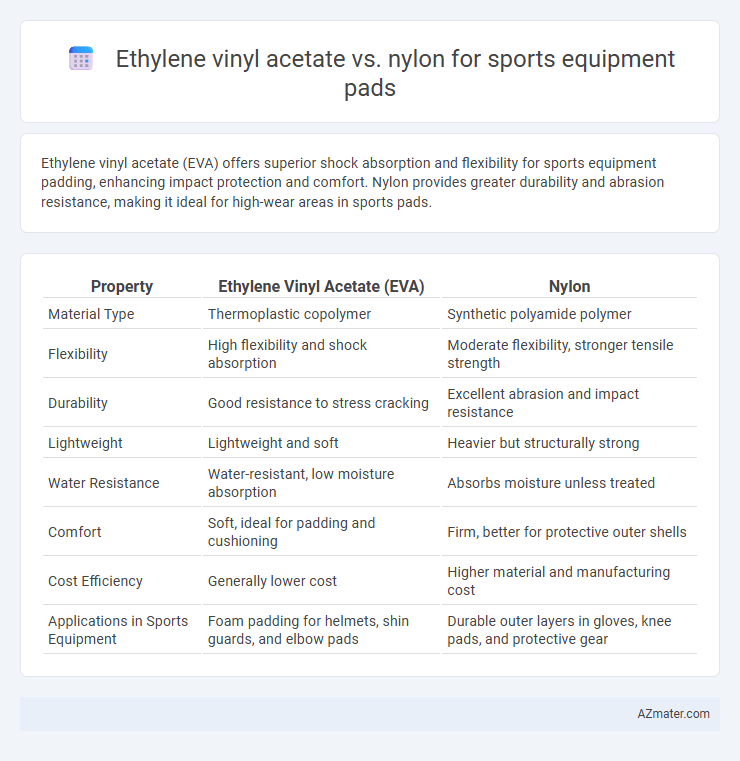Ethylene vinyl acetate (EVA) offers superior shock absorption and flexibility for sports equipment padding, enhancing impact protection and comfort. Nylon provides greater durability and abrasion resistance, making it ideal for high-wear areas in sports pads.
Table of Comparison
| Property | Ethylene Vinyl Acetate (EVA) | Nylon |
|---|---|---|
| Material Type | Thermoplastic copolymer | Synthetic polyamide polymer |
| Flexibility | High flexibility and shock absorption | Moderate flexibility, stronger tensile strength |
| Durability | Good resistance to stress cracking | Excellent abrasion and impact resistance |
| Lightweight | Lightweight and soft | Heavier but structurally strong |
| Water Resistance | Water-resistant, low moisture absorption | Absorbs moisture unless treated |
| Comfort | Soft, ideal for padding and cushioning | Firm, better for protective outer shells |
| Cost Efficiency | Generally lower cost | Higher material and manufacturing cost |
| Applications in Sports Equipment | Foam padding for helmets, shin guards, and elbow pads | Durable outer layers in gloves, knee pads, and protective gear |
Introduction to Ethylene Vinyl Acetate and Nylon
Ethylene vinyl acetate (EVA) is a lightweight, flexible polymer known for its excellent shock absorption and cushioning properties, making it ideal for sports equipment pads such as insoles and protective gear. Nylon, a synthetic polyamide, offers high tensile strength, abrasion resistance, and durability, often used in sports equipment requiring robust impact protection and long-lasting wear. Both materials provide distinct advantages, with EVA prioritizing comfort and shock mitigation while nylon emphasizes strength and durability.
Material Properties: EVA vs Nylon
Ethylene vinyl acetate (EVA) offers superior shock absorption and flexibility, making it ideal for sports equipment pads requiring cushioning and impact resistance. Nylon provides exceptional abrasion resistance and tensile strength, ensuring durability and structural integrity under high-stress conditions. EVA's lightweight and soft texture enhance comfort, whereas Nylon's toughness supports prolonged use and shape retention.
Durability and Lifespan in Sports Pads
Ethylene vinyl acetate (EVA) offers excellent impact absorption and maintains flexibility over extended use, making it highly durable for sports equipment pads. Nylon is known for its superior abrasion resistance and tensile strength, contributing to a longer lifespan under intense physical activity. For sports pads, EVA provides cushioning that resists wear from repeated shocks, while nylon enhances structural integrity, ensuring pads remain effective during prolonged athletic performance.
Comfort and Fit Considerations
Ethylene vinyl acetate (EVA) offers superior cushioning and flexibility, making it ideal for sports equipment pads that require enhanced shock absorption and a snug fit. Nylon, while durable and abrasion-resistant, often lacks the same level of softness and adaptability for personalized comfort, which can affect prolonged wear. Choosing EVA over Nylon generally enhances comfort by better contouring to body shapes and reducing pressure points during intense physical activity.
Shock Absorption and Impact Resistance
Ethylene vinyl acetate (EVA) offers superior shock absorption due to its soft, flexible, and lightweight properties, making it ideal for sports equipment pads that require effective cushioning and energy dispersion. Nylon, while more durable and abrasion-resistant, provides less impact cushioning as it is stiffer and less compressible compared to EVA. Choosing EVA enhances protection against impact forces in sports activities, whereas nylon prioritizes structural integrity and wear resistance over shock absorption.
Moisture Management and Breathability
Ethylene vinyl acetate (EVA) offers superior moisture management by resisting water absorption, making it ideal for sports equipment pads that require quick drying and consistent performance under sweaty conditions. Nylon, while durable and lightweight, tends to absorb more moisture, which can lead to reduced breathability and increased discomfort during prolonged wear. The closed-cell structure of EVA enhances breathability by preventing moisture buildup, whereas nylon's woven fibers allow some air flow but retain more perspiration, impacting overall athlete comfort.
Weight and Flexibility Comparison
Ethylene vinyl acetate (EVA) offers lightweight cushioning with excellent flexibility, making it ideal for sports equipment pads requiring agility and shock absorption. Nylon, while durable and resistant to abrasion, tends to be heavier and less flexible, which can reduce comfort and responsiveness in dynamic movements. For optimal performance in sports gear, EVA's combination of low weight and superior flexibility outperforms nylon in applications demanding mobility and impact resistance.
Maintenance and Cleaning Requirements
Ethylene vinyl acetate (EVA) sports equipment pads offer easy maintenance due to their water-resistant and non-absorbent properties, allowing for quick cleaning with mild soap and water without degrading the material. Nylon pads, while durable, require more careful cleaning to prevent moisture retention and potential odor buildup caused by their porous fabric structure, often necessitating air drying and periodic deep cleaning for hygiene. Choosing between EVA and Nylon depends on the importance of low-maintenance care versus breathable comfort and durability in sports padding.
Cost-Effectiveness for Manufacturers and Consumers
Ethylene vinyl acetate (EVA) offers superior cost-effectiveness for manufacturers and consumers due to its lower production expenses and versatile performance in sports equipment padding. Nylon, while providing higher durability and abrasion resistance, typically incurs greater manufacturing costs that can increase retail prices. Choosing EVA often results in affordable, lightweight padding solutions without compromising comfort, making it a preferred option for budget-conscious markets.
Environmental Impact and Sustainability
Ethylene vinyl acetate (EVA) is a lightweight, flexible foam material commonly used in sports equipment pads due to its excellent shock absorption and durability, but its production involves non-renewable petroleum resources and challenges in biodegradability. Nylon, a durable synthetic polymer known for high tensile strength and abrasion resistance, also relies heavily on fossil fuels and generates significant carbon emissions during manufacturing, with limited recyclability posing sustainability concerns. Both materials present environmental impacts, yet advancements in bio-based alternatives and recycling programs aim to improve the sustainability profiles of EVA and nylon in sports equipment applications.

Infographic: Ethylene vinyl acetate vs Nylon for Sports Equipment Pad
 azmater.com
azmater.com